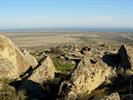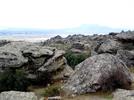The rock-carving Gobustan, a state-protected reserve situated 40 miles south of Baku, date back to the Stone Age.
Gobustan, in translation, means "ravine land". The spurs of the Great Caucasus Range descend to the sea here along the river Djeiran-kechmez (in translation-"where the djeiran (saiga deer) will not pass"). The soft clay soil led to the formation of numerous ravines. The local rock surface has the following remarkable qualities: it lends itself to carving, while at the same time being extraordinarily weather-resistant. These factors were to play a role in primitive man's choice of this site for his open-air "picture gallery".
The rock carvings were first discovered in 1939 by the Azerbaijan archaeologist and ethnographer I. M. Djaffar zade. During the 25 years he spent exploring the area, the scholar found about 4,000 petroglyphs on 700 rock faces of the Beyukdash and Kichikdash ("Big Rock", "Small Rock") mountains. He took in rubbings and catalogued each of them. His work was continued by the archaeologist D. Rustamov who found another 2,000 petroglyphs. In 1966 Gobustan was declared to be a national reserve and put under the protection of the state.
Apart from the extremely interesting petroglyphs, caves that were man's abode in the Stone Age can be seer area which at the time was rich in vegetation and good for hunting in view of its natural traps passages, steep drops, etc. - attracted human habitation. Note the holes drilled through the rocks with stone implements: here trapped wounded animals were tied up a provision against famine or unsuccessful hunting. There were probably tended-the first step towards domestication.
The men in the petroglyphs wear loin-cloths and powerful legs as befits hunters who run fast. The women have their breasts and hips emphasized as symbol of procreation; their arms are not shown, but they aremed with bows. There are representations of cult ceremnies and everyday life. There is a picture of a group dance for instance, which is done in a circle with arms on each other's shoulders - forerunner of the yalla danced in Azerbaijan to this day. Linguistically "yalla" is cognate to "yal" which means "food". The "food dance" was presumably a magic rite done before hunting. It might also have served as good training for huntsmen-nimble synchronous movements are essential in collective chase. Note the stone "tambourine" which emits a booming sound when it is struck, it was probably used for accompaniment to the yalla dance. There is a picture of people in a dugout boat, also of sea going bamboo boats.
There are pictures of bulls, wild Coolan donkeys, rock goats, deer, lions, gazelles, wild boars, snakes, lizards; of various symbols and signs, including the cross and swastica symbols for the sun in the East. Most petroglyphs show the sure hand af a master for they display an ingeni-ous use of convention in depicting the human figure and keen powers of observation in depicting the animals in movement or repose Some are masterpieces of daring and realism, others are done over older carvings. In addition to the rock carvings, the traces of early man's camps dating from the Mesolithic period is to be seen at Gobustan, and twenty burial mounds and graves, the most interesting being the Firuz burial (8,000 B.C).
The bowl-shaped depressions carved out in the rock were probably used for collecting rainwater, the blood of sacrificed animals or for cooking. Until quite recently mountain shepherds used these "bowls" for boiling milk by dropping heated stones into them. It is quite probable that the ancients had a similar use for the "bowls". One such stone is known as the "Gobustan kitchen". Another notable find is a stone with an inscription left behind by one of Alexander the Great's cohorts.
Gobustan may be seen as a unique source of knowledge on the period from the 10,000 B.C. to the Middle Ages covering the fields of history, culture, art and archaeology. There is the museum which contains a collection of excavated objects: tools and shells of non-Caspian origin - evidence of links with the Mediterranean and the Indian Ocean areas; early ceramic vessels of the 6,000 B.C. Stone beads and other objects from the Firuz burial mound in which eleven skeletons of the Mesolithic period were found. The most interesting exhibits are traces of black resin like glue for mending broken vessels or making tools and a crucible indicating that the ancient inhabitants of Gobustan knew how to smelt metal. The exhibition also contains rubbings of the most artistically perfect rock-carvings; a 200-year-old Gobustan carpet, some modern works of art influenced by Gobustan, etc.
If you're planning a trip to Azerbaijan you may be interested ▶ Azerbaijan highlights - For those who prefer to go unbeaten path, to explore less visited places and check national charisma of this small country in Southern Caucasus on the edge of Europe.














